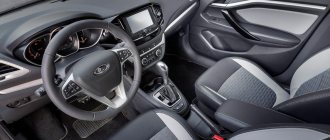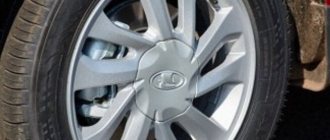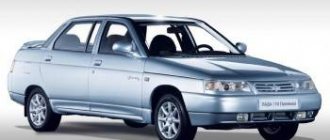Once upon a time, Tolyatti Ladas were very popular in the post-Soviet space. Many people dreamed of such a car. But time passes, and foreign cars have successfully replaced the products of the native automobile industry.
Foreign cars were more attractive in appearance, more convenient to use, more reliable, and so on. Plus, they've always been more fashionable. In general, our auto industry was inferior to imported ones in all respects. It has become more profitable to buy a used, but foreign car than a new domestic car. But now new Ladas have appeared on the assembly line, and the patriots of the domestic automotive industry have new hope.
The head of state himself began the test drive for the Lada Vesta car. Actually, as befits a leader interested in developing domestic production, and not in feeding foreign producers. Of course, such a test drive could not be unsuccessful. That is why many car enthusiasts simply did not believe the results. But then independent experts - journalists, potential buyers and simply motorsport fans - got down to business. And here the Lada Vesta test drive turned out to be much more interesting.
Content
- X-face outside
- Cheap and spacious inside
- Silence, like in a library
- Well, let's go!
- Impressions from the “Russian girl”
I have wanted to test Vesta for a long time, since the days of working at the Hyundai car dealership. Then many clients spoke flatteringly about it, comparing it with Solaris, but I didn’t believe it - it’s AvtoVAZ!
And finally we met. For the test I got a LADA Vesta SW in the maximum Luxe/Prestige configuration with a 1.6 engine with manual transmission. Not the most interesting option in terms of units, but the most popular.
X-face outside
From the outside, the car looks quite modern, like an adult. The body panels fit perfectly: the gaps are minimal and even. The general X-shaped style can be seen everywhere: in the side stampings, in the front part, and in the rear headlights. The turn signals are built into the mirrors. There are neat aerodynamic roof rails on the roof, and the antenna is made in the form of a fin.
The only thing I didn’t like was the huge gas tank filler cap, which, judging by the sound of opening, was made of tin.
Also read: Which is better to take: a new LADA Vesta or a used Hyundai Solaris
Chassis behavior
Let's move on to driving performance. Interior noise insulation is at a quite decent level. For a car in the budget price category, the noise levels in the cabin are quite good. But it would be better to replace the front strut boots. They are made of dense plastic, so when the suspension operates they create additional noise.
The suspension itself is adjusted very well. The designers managed to find the optimal balance between smoothness and rigidity. Therefore, the suspension handles unevenness well and provides decent comfort.
The designers also did a good job on the steering. Optimal operation of the electric booster gives the car good handling.
As for the braking system, its disadvantage can be considered the use of drum mechanisms on the rear axle. They still read somewhat outdated. And there is a high probability of the pads sticking in winter when using the handbrake. This drawback on the West station wagons, which are preparing for release, has been eliminated and disc brakes have been installed at the rear.
Cheap and spacious inside
The door opened easily, with half a touch of the handle, and slammed just as pleasantly and easily. The front passenger seat is spacious for my height (181 cm) - my knees don’t rest anywhere, the belt is height-adjustable and doesn’t rub my collarbone. There are three-stage heated seats and cup holders. The cup holders are shallow and inconvenient to use: on strong bumps, hot coffee can fly out and scald your knee.
The interior was not surprising. A lot of cheap, “mismatched” plastic, some “childish” multi-colored inserts on the panel and door cards, an instrument panel with orange scales “a la sport”, which distract from the digital values. The location of the buttons, the convenience and range of adjustment of the seat and steering wheel do not raise any questions. By the way, even the lumbar support is adjustable here, which is rare for this class.
The rear seats are comfortable. There is a decent margin in front of the knees, as well as above the head. The seats are molded for two, but since there is a middle headrest, three can ride, the amount of space in the waist and shoulders allows this. But it’s still more convenient for two. The couple is provided with heated seats and a center armrest with cup holders. There are also USB and 12-volt charging ports to choose from.
The trunk caused admiration - there is no other way to say it. It’s not like in the “economy”, in the C-class I don’t remember anyone having such a carefully thought-out luggage compartment. Volume - 480 liters, regular rectangular shape. On the right is a closed niche for small items. On the left are several compartments for small items and a mesh. There are a bunch of hooks, a 12-volt socket, two niches in the raised floor and a sliding shelf. Low bow to the engineers!
Also read: Which is better: Vesta or Polo
A little about the salon
Let's move on to the salon. The doors open easily, and you don’t need to make any special efforts to close them. The interior is good in terms of usable space; passengers clearly will not feel cramped.
The seating position is comfortable, and the driver’s seat and steering column adjustments allow almost any car owner to customize the driver’s seat.
The general appearance of the front panel is well designed by the designers, so it looks very good and stylish.
Vesta's visibility is very decent. The road is sufficiently visible, and large side mirrors allow you to clearly control what is happening to the side and behind the car.
The heated seats work just fine. They warm up quickly and within a couple of minutes the seats are warm. The storage box is very spacious.
But there are also disadvantages, although they are minor. These include a slight difficulty in reading information from the dashboard. And here the stylistic design is to blame. The wells are distracting with their shape and chrome, and the driver needs to pay more attention to the indicators of the sensors. Although, as you get used to it, this problem may disappear.
You can display a lot of information on the on-board computer, but the backlight is not very good, so the numbers are not very readable, and you have to look closely at them.
Setting up the computer is also difficult. Its function keys are located, as on many cars, at the end of the right steering column switch. The problem lies in the fact that to configure some parameters you need to perform certain manipulations - hold down both keys, hold them for a certain time, etc.
The location of the USB and AUX outputs, as well as the cigarette lighter, is also inconvenient. They were placed under the climate system unit in the rear wall of the storage niche. Therefore, getting to them is not very easy.
In general, it is better to set up the on-board computer and connect to the cigarette lighter before you start driving. But these are all minor flaws that can be found in any car. The overall impression of the cabin is that the build quality is slightly lacking. But for AvtoVAZ it’s forgivable. The rest of the interior is very good and in line with current trends.
Related link:
We open the Lada Vesta with a spare key.
Silence, like in a library
The first impression was very pleasant. What will it be like on the go? I start it up and am amazed - the engine is barely audible. I must say that Vesta’s sound insulation is generally very good (hello, Koreans!). Here, even the protection of the rear arches is piled, so the noise from the wheels and the road is almost inaudible.
It is better not to turn on the audio system only when listening to audiobooks. The sound quality leaves much to be desired, as does the quality of the touch display. The graphics are unclear, the response to clicks is slow, and you have to wait to turn on the camera...
Also read: Who is sportier: LADA Vesta Sport I or Skoda Rapid I turbo
Filter by brands and models all test drives
- A Acura
- Alfa Romeo
- Alpina
- Alpine
- Aston Martin
- Audi
- Aurus
- B Bajaj
- Bentley
- BMW
- Brilliance
- Bugatti
- BYD
- C Cadillac
- Caterham
- Changan
- Chery
- CheryExeed
- Chevrolet
- Chrysler
- Citroen
- Daewoo
- Daihatsu
- Dartz Motors
- Datsun
- Detroit Electric
- DFM
- Dodge
- FFAW
- Ferrari
- Fiat
- Ford
- Foton
- G GAC
- GAZ
- Geely
- Genesis
- GMC
- Great Wall
- GTA Motor
- H Hafei
- Haima
- Haval
- Hawtai
- Hennessey
- Honda
- Hummer
- Hyundai
- I Icon
- Infiniti
- Iran Khodro
- Isuzu
- JJAC
- Jaguar
- Jeep
- K KIA
- Koenigsegg
- L Lada
- Lamborghini
- Land Rover
- Lexus
- LIFAN
- Lincoln
- Lotus
- Luxgen
- M Marussia
- Maserati
- Maybach
- Mazda
- Mazzanti
- McLaren
- Mercedes-Benz
- MG Cars
- MINI
- Mitsubishi
- N Nissan
- Opel
- P Pagani
- Peugeot
- PGO
- Porsche
- Proton
- Q Qoros
- Ravon
- Renault
- Rolls-Royce
- S Saab
- Samsung
- SEAT
- SeAZ
- Skoda
- Smart
- SsangYong
- Subaru
- Suzuki
- T TagAZ
- Tata
- Tesla Motors
- Toyota
- Troller
- TVR
- V Volkswagen
- Volvo
- WW Motors
- Wiesmann
- Z ZAZ
- Zotye
- ZXAuto
- Yo Yo-auto
- 2104
- 2107
- 2110 (2111,21112)
- 4×4
- Granta
- Granta Cross
- Granta Sport
- Kalina
- Kalina Cross
- Kalina NFR
- Kalina Sport
- Largus
- Largus Cross
- Priora
- Samara
- Vesta
- Vesta Cross
- Vesta Sport
- XRay
- Xray Cross
showing 1 - 7 of 7 tests
Well, let's go!
Vesta almost didn’t notice the asphalt joints, but on the snow frozen in mounds it seemed a little harsh, however, no breakdowns were observed. The hard plastic began to rattle over bumps, although not as much as some competitors. It is better to press the brake smoothly and in advance; if you press the pedal a little harder, ABS will intervene, which is sometimes out of place, and the braking distance increases by a couple of meters.
I drive out onto a cleared road and am surprised at how composed the car behaves at high speed. In terms of handling, Vesta was reminiscent of younger VAGs. She reacted sharply to steering movements and only returned to zero reluctantly.
What it really lacked was dynamics. When overtaking, I wanted to go out and push. Perhaps the 1.8 drives better, but the 1.6 is definitely not for the highway, and the gearbox is tuned for the city. The gears are short, most likely to save fuel. Therefore, already at 60 you can safely stick in the fifth. The car pulls calmly, but changing gears is not very convenient. The travel of the gearshift lever, as well as the clutch pedal, is long.
You can drive over large uneven surfaces without fear of tearing off the bumper. The ground clearance here feels like a regular SUV - 178 mm, which Vesta does not pretend to achieve at all. For this purpose there is a raised version of Cross. But this is the only way our car could cope with a gravel road or crossing a curb.
Also read: Five facts for and against buying a Lada Vesta
We accelerate and go
But a test drive of a Lada Vesta begins not with an inspection of the car, but with a ride in it. It is the ride that determines whether the car is really comfortable or whether it only seems so while it sits comfortably in the parking lot.
While the engine is idling, it is practically inaudible in the cabin, and this seems strange when you remember that the car is domestic. In addition, the first sounds appear at 3500 rpm, and at speeds exceeding 100 km/h, you can talk calmly without trying to shout over the car noise.
When taking the Lada Vesta car for a test drive, an interesting nuance emerged: the rated maximum speed is 178 km/h, and the speedometer showed more than 190 km/h! And this cannot be attributed to problems with the speedometer, since the GPS sensor showed that the speed was 186 km/h.
When driving a LADA with a robotic gearbox, after 160 km/h the hood opening sensor began to light up, while the hood itself remained safely closed. Testers believe that the hood was simply not installed quite accurately on a particular car, that is, this is not a defect of the brand, but simply an isolated error. This happens with pre-production cars. Moreover, nothing similar was found on another LADA Vesta - with a conventional manual transmission.
The Lada Vesta took a test drive in Italy, which is famous for its winding roads that are not particularly smooth. Steep descents and ascents are characteristic of Italian roads, especially in the mountainous regions of the country. Even on city streets there are an abundance of sharp turns, descents and ascents can compete with the mountains. But the Lada successfully passed all road tests, and the car passed even in the most unfavorable conditions at a fairly high speed. Testers claim that it’s all about the character of the car itself - they call it groovy! The car blends so well with the driver that it’s tempting to step on the gas. Moreover, imported electric power steering allows you to perform almost aerobatics, entering one turn after another. Also during the test, the neutral balance of the chassis was noted, and the Lada Vesta could go into a skid solely with the help of the handbrake. In addition, everything is under the control of the ESP stabilization system - it turns off only at low speeds, when skidding becomes almost impossible.











